IT Gets Fit
Articles and Tips: article
01 Aug 2005
Shrinking Your IT costs with Linux
Every day we hear about more companies making the switch to Linux. In fact, Gartner recently predicted that Linux will have the strongest relative growth of any server operating system during the next five years (Source: Gartner, 4 April 2005). With major vendors such as Novell, IBM and Sun backing open source initiatives, it's no wonder the base of available products and services for Linux is growing at a phenomenal pace. Today you have more reasons than ever before to make the switch, not the least of which is because "everyone's doing it."
Security and Stability
Attend any Linux conference and you'll hear system administrators brag, not about the issues they have with their OS, but about their "uptime" (the time since their system was last rebooted). That's because Linux is one of the most stable enterprise OSs available today.
Protected at the Core
The core of Linux, or kernel, is separated from the applications that run on the OS. This separation means that applications running on the system don't have the access necessary to destabilize the system. This strong design feature provides the stability and security for which Linux is known. In addition, as with many open source projects, several hundred people with varied experience and insight examine the Linux core. Each brings a fresh perspective and contributes improvements to the system. With that many people reviewing the code, it's no wonder Linux is so refined.
Application Security
Linux works on a "least permissions" philosophy: do your work with only the permissions you need. This makes auditing the actions of administrators easier while increasing the overall security of the system. (See Figure 1.) This philosophy extends further than to just administrators. Applications and services on the system also use this philosophy and enjoy this same level of security, which makes Linux an unattractive target for hackers.
Figure 1: Linux tools, such as RPM, make compliance auditing a snap!
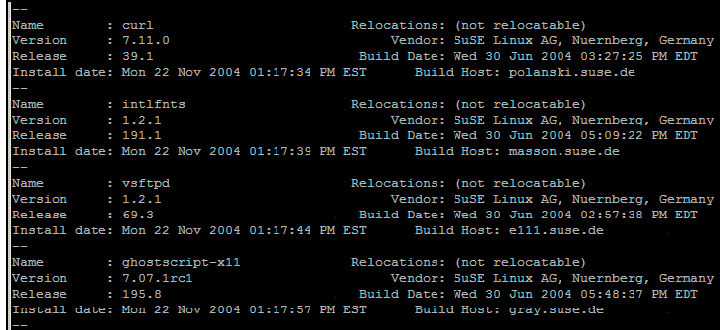
A variety of software exists that provides enhanced security and keeps a watchful eye on running applications. An excellent example of this is Novell AppArmor Powered by Immunix. (See Figure 2.) When applications operate outside their bounds, they can be stopped by these "watchdogs." This kind of proactive security, which was developed in conjunction with DARPA, helps eliminate intrusions as they occur and squash exploits before they affect your business. (DARPA, or The Defense Advanced Research Projects Agency, is the central research and development organization for the U.S. Department of Defense.) This type of technology even works on exploits that have recently emerged, or are thought not to exist.
Figure 2: Novell AppArmor Powered by Immunix has an easy-to-use interface and uses a unique attack prevention technology to protect Linux applications and prevent exploitation?even at the kernel level.
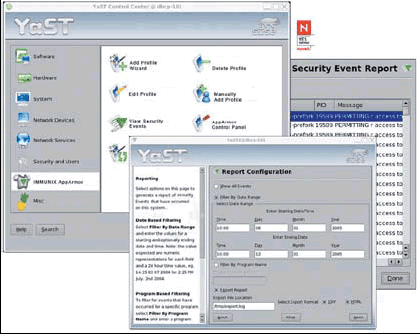
Secure Access and Administration
Open source also provides implementations of many secure access methods, such as industry standards RSA, DSA and DES encryption, which enable secure remote access and administration. Linux also implements and is compatible with most industry standard security authentication mechanisms, such as Kerberos and SecurID, not to mention Windows NT and 2000 authentication.
Shrink I.T. and Implementation Costs
When you implement Linux, you'll quickly see the effects on your bottom line. The movement of core services to Linux, such as file services, print services, DNS, firewall services and Web services, helps virtually eliminate licensing and maintenance fees, provide increased reliability and a reduced need for regular maintenance. These features and functions translate directly to an increased operating efficiency, an improvement in ROI, and in many cases, an increase in overall gross revenue. (How much money does your company lose each time your core infrastructure is down or is slow?) Combine that with the fact that Linux systems run on commodity hardware and you have a winning proposal. In fact, Linux clustering solutions enable companies to create redundant arrays of cheap hardware. This enables you to build low-cost, redundant systems that scale well. For example, Google's search engine business is built on this type of infrastructure today.
Linux servers can also be used as NT domain controllers using Samba. (See Figure 3.) And soon, with Samba 4, they will also be able to function as your Active Directory domain controller so you can easily eliminate those expensive server and Client Access Licenses. These and other important features allow you to migrate your server or workstation infrastructure with little or no impact to the rest of your operating environment. It's no wonder more and more companies are moving toward Linux. In fact, analyst firm IDC already predicts that Linux revenues will grow 26 percent annually, to $35.7 billion in 2008. (See Figure 5.) (Source: DesktopLinux.com. For more information, see Linux, Inc..)
Figure 3: Using Linux, you can browse and use Windows network file shares just as you would in Windows. You can also access Linux shares from within Windows. In addition, Linux tools, such as Samba, replace services provided by Windows, without expensive Client Access Licenses.
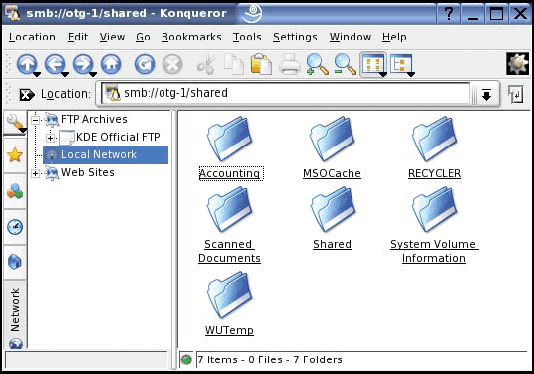
Leveraging Open Source
Linux can help you leverage the work of the open source community to do things better, faster and cheaper than ever before. The availability of well-designed, free software is so prolific, when you start looking for Linux applications, you'll constantly hear "it's been done before...and it's probably free!" The end result of all this is that Linux gives you the ability to reallocate resources you spent on other applications where they're really needed.
If you're wondering what Linux apps are available out there, read "Full Steam Ahead" in the September/October 2004 issue. It provides a partial list of open source applications that effectively replace many of their Windows counterparts. Check out the list; you'll find that not only is there no need to reinvent the wheel, but also there's already a wide range of "wheels" from which to choose.
Impressive Desktop Savings
If you combine a switch to Linux in the core with a switch to Linux on the desktop, the numbers look even better. Linux solutions for the desktop provide similar (and sometimes greater) cost savings. According to Gartner, if you install Linux and StarOffice on the desktop, you'll save approximately $154 USD per system when you examine hardware and software costs. Install OpenOffice (available freely at OpenOffice.org and based on StarOffice) and you'll save even more.
Furthermore, that savings doesn't include the management savings that comes from stronger security and increased reliability, nor the savings from purchasing and maintaining antivirus software. (See "Linux and Windows Security Compared," NewsForge, May 25, 2004.)
In fact, ICSA Labs estimate that every severe virus encounter costs a company approximately $100,000 USD in downtime and administrative costs. (Source: ICSA Labs.) The switch to Linux virtually eliminates such issues.
Desktop migrations from Windows to Linux can be easy to implement with the wide variety of both open source software and Windows compatibility software freely available on Linux. In fact, IDC forecasts Linux penetration in the desktop PC realm will reach $10 billion in annual revenues, on 17 million units shipped globally, by 2008. (Source: DesktopLinux.com.)
Working with custom applications that you built in-house? Linux IDEs give you the flexibility to make the switch with products such as Mono, which provides equivalent open source support for your applications.
Still not convinced you can make the switch? Products such as WINE and Crossover Office provide a Linux implementation of Windows libraries. Unlike emulators, which have significantly more overheard and can run slowly, Crossover Office and WINE let Windows applications run natively on Linux. It's a proven method of easing the migration. In fact, companies such as Disney use Crossover Office to run Windows applications, such as Photoshop, in their Linux environment. (For more information, see www.codeweavers.com and www.winehq.org.)
With the recent release of Novell Linux Desktop, companies now have a clear and viable choice when choosing their desktop environment. Novell Linux Desktop is built on top of the SUSE LINUX software distribution and provides pre-configured interoperability with Windows file shares (See Figure 3), Exchange messaging services and Microsoft Office-compatible applications (OpenOffice.org).
Furthermore, Novell Linux Desktop provides the security, scalability and remote manageability for which Linux is known, so a switch from a Windows desktop to a Linux desktop might be as simple as reinstalling software. Linux is able to integrate with your current network infrastructure and authentication mechanism, allowing you to slowly migrate systems over time while not making modifications to other parts of your network, software or servers. As a result, no harsh cut over is required and systems can be migrated when the time is right.
Spend Less Money Managing
So if you do attend one of those Linux events and you hear administrators bragging about their "uptime," you'll know that they can't take all the credit-Linux just makes them look good: less downtime, more available resources and more time to spend working on new projects. Patches and upgrades to Linux systems generally don't require reboots, and in many cases don't even require an interruption of running services. Upgrades are tested and security patches are rarely noticed by anyone but hackers. When was the last time you heard about a Linux patch causing a system to go down or a user to get locked out?
Linux can be installed on almost any set of hardware and software, and tools such as AutoYaST ensure that system imaging is a thing of the past. The operating system can be installed with a simple reboot of your PC, regardless of the hardware configuration, eliminating the need for expensive imaging tools (though open source imaging tools do exist). Installation and configuration is done on demand from scratch and without requiring an administrator. Innovations such as these allow administrators to shift their time to desktop or server support tasks.
A New Way of Thinking
Linux also presents you with some fundamental shifts in thinking that enable you to do things bigger and better than ever with an enterprise-grade OS that is already flourishing.
Linux Provides Interoperability
Linux runs on most enterprise computing platforms, and SUSE LINUX supports the latest hardware features, such as SATA, straight out of the box. The Linux community works hard to ensure that the latest standards are implemented and available and the latest hardware products are supported. In addition, the world's largest PC OEMs and suppliers such as AMD, Dell, HP, IBM and Intel, increasingly offer plug-and-play support for Linux.
The interoperability doesn't stop at hardware though: Linux has products and services (most are open source) that provide interoperability with most Internet standards and proprietary protocols and formats. For example, the latest version of OpenOffice.org provides unsurpassed compatibility with the Microsoft Office suite of products and is virtually a drop-in replacement for MS Office. In fact, according to a recent article on http://slashdot.org, OpenOffice.org recently saved the day for the head of the Microsoft Ukraine office. Apparently, the Windows Tablet PC, which was connected to the projector, malfunctioned; so they switched to the presenter's laptop which was already running Linux and delivered the Powerpoint presentation via OpenOffice (Source: Slashdot.org.) Now that's compatibility worth talking about.
The Core OS is Decoupled from the Applications
Every application that runs under Linux is installed as a separate package, or piece of software. Decoupling the applications from the OS gives you the ability to perform granular updates to the system. The most useful aspect of this is that we can apply patches at the software level and track patches at that level as well. Furthermore, because software management information is handled in a central database, it's a cinch to produce reports that provide information about the software installed on a system, version information, vendor information and even installation dates.
Linux is Driven by the Community
Like most open source products, Linux is community driven. In other words, the philosophy is one of interoperability, manageability and ease of use. Market share isn't the dominant factor in design decisions, and the drive to do things "the right way" is always present. It also means that with Linux, your company can continuously take advantage of the innovations of the open source community as well as other companies. Innovative licensing mechanisms, such as the GPL, promote the sharing of work and collaboration of the community.
It's no surprise that the argument to switch to Linux is strong; it's buoyed by the fact that industry leaders, such as Novell and IBM, have been working on Linux solutions for years. Novell is committed to making your transition from Windows to Linux a smooth one. And to that end, Novell and its partners offer a wide range of consulting and implementation services that will help drive and simplify your move. red N
Linux, Inc.
"...Put it all together, and Linux has become the strongest rival that Microsoft has ever faced. In servers, researcher IDC predicts Linux' market share based on unit sales will rise from 24 percent today to 33 percent in 2007, compared with 59 percent for Windows?essentially keeping Microsoft at its current market share for the next three years and squeezing its profit margins." (See Figure 4.) That's because, for the first time, Linux is taking a bite out of Windows, not just the other alternatives, and is forcing Microsoft to offer discounts to avoid losing sales.
Figure 4: IDC expects Linux to continue biting at the heels of Windows market share and increase from 24 percent to 33 percent within two years forcing Microsoft to swallow even smaller profit margins just to hold on to their share.
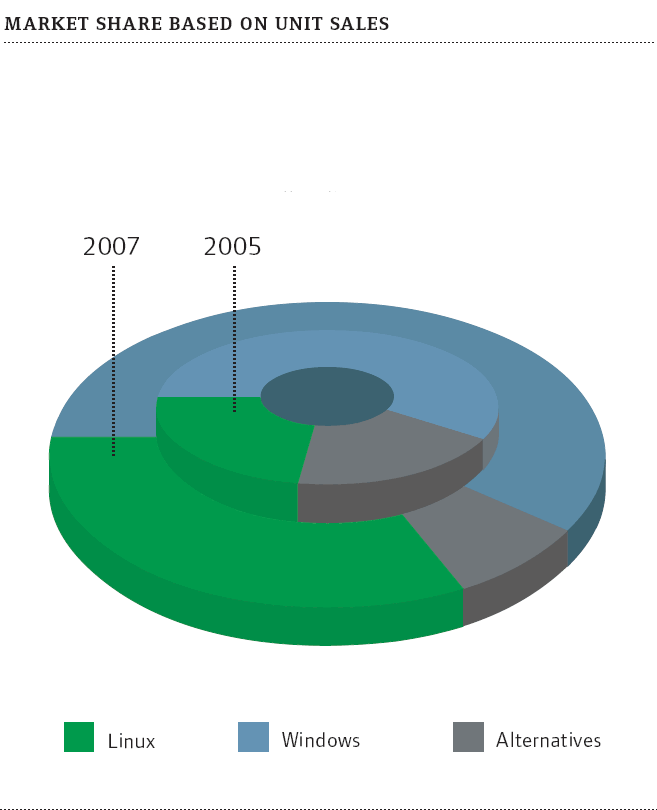
"In a survey of business users by Forrester Research Inc. (FORR), 52 percent said they are now replacing Windows servers with Linux. On the desktop side, IDC sees the Linux share more than doubling, from 3 percent today to 6 percent in 2007, while Windows loses a bit of ground. IDC expects the total market for Linux devices and software to jump from $11 billion last year to $35.7 billion by 2008." (See Figure 5.)
Figure 5: An IDC study expects the total revenue of Linux to more than triple to almost $36 billion US from $11 billion in only three years.
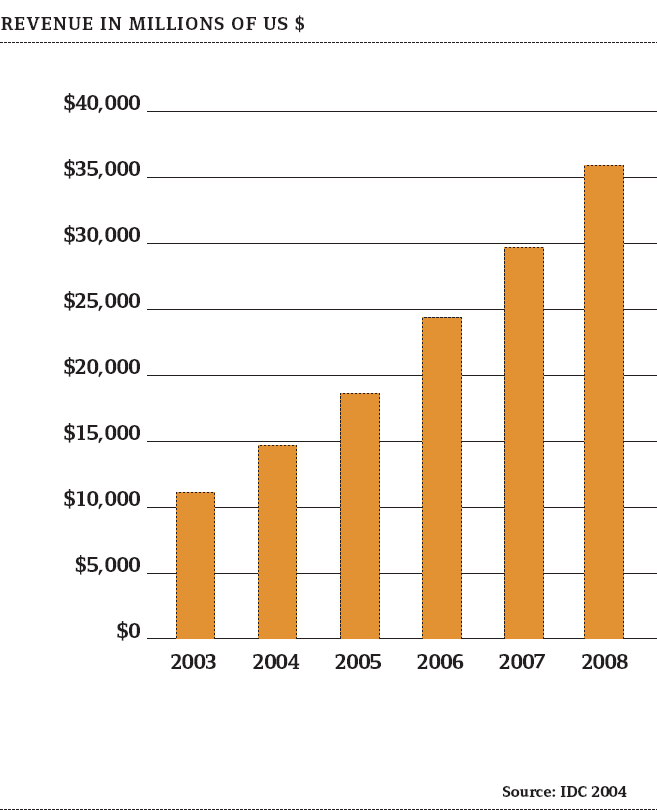
Source:
* Originally published in Novell Connection Magazine
Disclaimer
The origin of this information may be internal or external to Novell. While Novell makes all reasonable efforts to verify this information, Novell does not make explicit or implied claims to its validity.